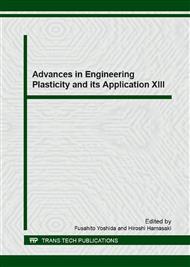p.445
p.451
p.456
p.465
p.471
p.477
p.483
p.489
p.495
Influence of Geometrical Imperfection on Failure Mode of DP780 Steel Utilizing Damage Models Embedded RVE Technique
Abstract:
As dual-phase (DP) steel sheet is widely used in automotive manufacture, researches on failure mode of DP steel have been carried out experimentally and numerically in recent years. In this paper, failure mode of DP 780 steels with geometrical imperfection, which was assumed as a consequence of previous process, was investigated via a microstructure approach utilizing RVE technique. Multiple damage models were applied on characteristic microstructures and the modified pointed-ended geometrical imperfection was ingrained. Considering the progress of crack evolution, the depth and the location of geometrical imperfection were critical factors in determining the mode of crack initiation and propagation. Essentially, geometrical imperfection influenced the failure mode of investigated DP steel via aggravating the structural heterogeneity.
Info:
Periodical:
Pages:
471-476
Citation:
Online since:
December 2016
Authors:
Price:
Сopyright:
© 2017 Trans Tech Publications Ltd. All Rights Reserved
Share:
Citation:


